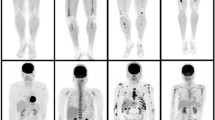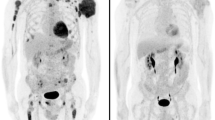Abstract
Purpose
We investigated the potential value of 11C-acetate (ACT) PET/CT in characterizing multiple myeloma (MM) compared with 18F-FDG PET/CT. Bone marrow histological and whole-body (WB) MRI findings served as the reference standards.
Methods
In this prospective study, 15 untreated MM patients (10 men and 5 women, age range 48−69 years) underwent dual-tracer 11C-ACT and 18F-FDG PET/CT and WB MRI for pretreatment staging, and 13 of them had repeated examinations after induction therapy. Diffuse and focal bone marrow uptake was assessed by visual and quantitative analyses, including measurement of the maximum standardized uptake value (SUVmax). Between-group differences and correlations were assessed with the Mann-Whitney U test and the Pearson test.
Results
At staging, all 15 patients had diffuse myeloma involvement upon bone marrow examination with 30–90 % of plasma cell infiltrates. Diffuse infiltration was detected in all of them (100 %) using 11C-ACT with a positive correlation between bone marrow uptake values and percentages of plasma cell infiltrates (r = +0.63, p = 0.01). In contrast, a diagnosis of diffuse infiltration could be established using 18F-FDG in only six patients (40 %). Focal lesions were shown in 13 patients on both 11C-ACT PET/CT and WB MRI, and in 10 patients on 18F-FDG PET/CT. Focal lesions demonstrated 11C-ACT uptake with a mean SUVmax of 11.4 ± 3.3 (range 4.6−19.6, n = 59), which was significantly higher than the 18F-FDG uptake (mean SUVmax 6.6 ± 3.1, range 2.3−13.7, n = 29; p < 0.0001). After treatment, the diffuse bone marrow 11C-ACT uptake showed a mean SUVmax reduction of 66 % in patients with at least a very good partial response versus 34 % in those with at most a partial response only (p = 0.01).
Conclusion
PET/CT using 11C-ACT as a biomarker showed a higher detection rate for both diffuse and focal myeloma lesions at diagnosis than using 18F-FDG, and may be valuable for response assessment.




Similar content being viewed by others
References
Rajkumar SV, Kyle RA. Multiple myeloma: diagnosis and treatment. Mayo Clin Proc. 2005;80:1371–82.
Rahmouni A, Divine M, Mathieu D, Golli M, Haioun C, Dao T, et al. MR appearance of multiple myeloma of the spine before and after treatment. AJR Am J Roentgenol. 1993;160:1053–7.
Lecouvet FE, Malghem J, Michaux L, Maldague B, Ferrant A, Michaux JL, et al. Skeletal survey in advanced multiple myeloma: radiographic versus MR imaging survey. Br J Haematol. 1999;106:35–9.
Durie BG, Salmon SE. A clinical staging system for multiple myeloma. Correlation of measured myeloma cell mass with presenting clinical features, response to treatment, and survival. Cancer. 1975;36:842–54.
Edelstyn GA, Gillespie PJ, Grebbell FS. The radiological demonstration of osseous metastases. Experimental observations. Clin Radiol. 1967;18:158–62.
Baur-Melnyk A, Buhmann S, Durr HR, Reiser M. Role of MRI for the diagnosis and prognosis of multiple myeloma. Eur J Radiol. 2005;55:56–63.
Durie BG. The role of anatomic and functional staging in myeloma: description of Durie/Salmon plus staging system. Eur J Cancer. 2006;42:1539–43.
McBrayer SK, Cheng JC, Singhal S, Krett NL, Rosen ST, Shanmugam M. Multiple myeloma exhibits novel dependence on GLUT4, GLUT8, and GLUT11: implications for glucose transporter-directed therapy. Blood. 2012;119:4686–97.
Hillner BE, Siegel BA, Shields AF, Liu D, Gareen IF, Hunt E, et al. Relationship between cancer type and impact of PET and PET/CT on intended management: findings of the national oncologic PET registry. J Nucl Med. 2008;49:1928–35.
Durie BG, Waxman AD, D'Agnolo A, Williams CM. Whole-body (18)F-FDG PET identifies high-risk myeloma. J Nucl Med. 2002;43:1457–63.
Zamagni E, Nanni C, Patriarca F, Englaro E, Castellucci P, Geatti O, et al. A prospective comparison of 18F-fluorodeoxyglucose positron emission tomography-computed tomography, magnetic resonance imaging and whole-body planar radiographs in the assessment of bone disease in newly diagnosed multiple myeloma. Haematologica. 2007;92:50–5.
Haznedar R, Aki SZ, Akdemir OU, Ozkurt ZN, Ceneli O, Yagci M, et al. Value of 18F-fluorodeoxyglucose uptake in positron emission tomography/computed tomography in predicting survival in multiple myeloma. Eur J Nucl Med Mol Imaging. 2011;38:1046–53.
Derlin T, Weber C, Habermann CR, Herrmann J, Wisotzki C, Ayuk F, et al. 18F-FDG PET/CT for detection and localization of residual or recurrent disease in patients with multiple myeloma after stem cell transplantation. Eur J Nucl Med Mol Imaging. 2012;39:493–500.
Bartel TB, Haessler J, Brown TL, Shaughnessy Jr JD, van Rhee F, Anaissie E, et al. F18-fluorodeoxyglucose positron emission tomography in the context of other imaging techniques and prognostic factors in multiple myeloma. Blood. 2009;114:2068–76.
Zamagni E, Patriarca F, Nanni C, Zannetti B, Englaro E, Pezzi A, et al. Prognostic relevance of 18-F FDG PET/CT in newly diagnosed multiple myeloma patients treated with up-front autologous transplantation. Blood. 2011;118:5989–95.
Dankerl A, Liebisch P, Glatting G, Friesen C, Blumstein NM, Kocot D, et al. Multiple myeloma: molecular imaging with 11C-methionine PET/CT – initial experience. Radiology. 2007;242:498–508.
Swinnen JV, Heemers H, Deboel L, Foufelle F, Heyns W, Verhoeven G. Stimulation of tumor-associated fatty acid synthase expression by growth factor activation of the sterol regulatory element-binding protein pathway. Oncogene. 2000;19:5173–81.
Yun M, Bang SH, Kim JW, Park JY, Kim KS, Lee JD. The importance of acetyl coenzyme A synthetase for 11C-acetate uptake and cell survival in hepatocellular carcinoma. J Nucl Med. 2009;50:1222–8.
Oyama N, Miller TR, Dehdashti F, Siegel BA, Fischer KC, Michalski JM, et al. 11C-acetate PET imaging of prostate cancer: detection of recurrent disease at PSA relapse. J Nucl Med. 2003;44:549–55.
Mena E, Turkbey B, Mani H, Adler S, Valera VA, Bernardo M, et al. 11C-Acetate PET/CT in localized prostate cancer: a study with MRI and histopathologic correlation. J Nucl Med. 2012;53:538–45.
Higashi K, Ueda Y, Matsunari I, Kodama Y, Ikeda R, Miura K, et al. 11C-acetate PET imaging of lung cancer: comparison with 18F-FDG PET and 99mTc-MIBI SPET. Eur J Nucl Med Mol Imaging. 2004;31:13–21.
Ho CL, Yu SC, Yeung DW. 11C-acetate PET imaging in hepatocellular carcinoma and other liver masses. J Nucl Med. 2003;44:213–21.
Ho CL, Chen S, Yeung DW, Cheng TK. Dual-tracer PET/CT imaging in evaluation of metastatic hepatocellular carcinoma. J Nucl Med. 2007;48:902–9.
Khoo SH, Al-Rubeai M. Metabolic characterization of a hyper-productive state in an antibody producing NS0 myeloma cell line. Metab Eng. 2009;11:199–211.
The International Myeloma Working Group. Criteria for the classification of monoclonal gammopathies, multiple myeloma and related disorders: a report of the International Myeloma Working Group. Br J Haematol. 2003;121:749–57.
Greipp PR, San Miguel J, Durie BG, Crowley JJ, Barlogie B, Blade J, et al. International staging system for multiple myeloma. J Clin Oncol. 2005;23:3412–20.
Rajkumar SV. Multiple myeloma. Curr Probl Cancer. 2009;33:7–64.
Durie BG, Harousseau JL, Miguel JS, Blade J, Barlogie B, Anderson K, et al. International uniform response criteria for multiple myeloma. Leukemia. 2006;20:1467–73.
Pike VW, Eakins MN, Allan RM, Selwyn AP. Preparation of [1-11C] acetate – an agent for the study of myocardial metabolism by positron emission tomography. Int J Appl Radiat Isot. 1982;33:505–12.
Ng SH, Yen TC, Liao CT, Chang JT, Chan SC, Ko SF, et al. 18F-FDG PET and CT/MRI in oral cavity squamous cell carcinoma: a prospective study of 124 patients with histologic correlation. J Nucl Med. 2005;46:1136–43.
Shon IH, Fogelman I. F18-FDG positron emission tomography and benign fractures. Clin Nucl Med. 2003;28:171–5.
Lin C, Luciani A, Belhadj K, Maison P, Vignaud A, Deux JF, et al. Patients with plasma cell disorders examined at whole-body dynamic contrast-enhanced MR imaging: initial experience. Radiology. 2009;250:905–15.
Lin C, Luciani A, Belhadj K, Deux JF, Kuhnowski F, Maatouk M, et al. Multiple myeloma treatment response assessment with whole-body dynamic contrast-enhanced MR imaging. Radiology. 2010;254:521–31.
Ghanem N, Lohrmann C, Engelhardt M, Pache G, Uhl M, Saueressig U, et al. Whole-body MRI in the detection of bone marrow infiltration in patients with plasma cell neoplasms in comparison to the radiological skeletal survey. Eur Radiol. 2006;16:1005–14.
Baur-Melnyk A, Buhmann S, Becker C, Schoenberg SO, Lang N, Bartl R, et al. Whole-body MRI versus whole-body MDCT for staging of multiple myeloma. AJR Am J Roentgenol. 2008;190:1097–104.
Shortt CP, Gleeson TG, Breen KA, McHugh J, O'Connell MJ, O'Gorman PJ, et al. Whole-body MRI versus PET in assessment of multiple myeloma disease activity. AJR Am J Roentgenol. 2009;192:980–6.
Moulopoulos LA, Dimopoulos MA, Christoulas D, Kastritis E, Anagnostou D, Koureas A, et al. Diffuse MRI marrow pattern correlates with increased angiogenesis, advanced disease features and poor prognosis in newly diagnosed myeloma treated with novel agents. Leukemia. 2010;24:1206–12.
Hillengass J, Fechtner K, Weber MA, Bauerle T, Ayyaz S, Heiss C, et al. Prognostic significance of focal lesions in whole-body magnetic resonance imaging in patients with asymptomatic multiple myeloma. J Clin Oncol. 2010;28:1606–10.
Schirrmeister H, Buck AK, Bergmann L, Reske SN, Bommer M. Positron emission tomography (PET) for staging of solitary plasmacytoma. Cancer Biother Radiopharm. 2003;18:841–5.
Bredella MA, Steinbach L, Caputo G, Segall G, Hawkins R. Value of FDG PET in the assessment of patients with multiple myeloma. AJR Am J Roentgenol. 2005;184:1199–204.
Lee SM, Kim TS, Lee JW, Kwon HW, Kim YI, Kang SH, et al. Incidental finding of an 11C-acetate PET-positive multiple myeloma. Ann Nucl Med. 2010;24:41–4.
Ho C-L, Chen S, Cheng T, Leung YL, Wong KK. Preliminary assessment of 11C-acetate and 18F-FDG PET/CT for the diagnosis and management of multiple myeloma. Society of Nuclear Medicine Annual Meeting Abstracts. 2011;52:369.
Cheung TT, Ho CL, Lo CM, Chen S, Chan SC, Chok KS, et al. 11C-acetate and 18F-FDG PET/CT for clinical staging and selection of patients with hepatocellular carcinoma for liver transplantation on the basis of Milan criteria: surgeon's perspective. J Nucl Med. 2013;54:192–200.
Acknowledgments
This study was supported by Chang Gung Memorial Hospital under grants CMRPG392041, CMRPG392042, CMRPG3A1231, and CMRPG3A1232.
Conflicts of interest
None.
Author information
Authors and Affiliations
Corresponding author
Additional information
Chieh Lin and Chi-Lai Ho contributed equally to this work.
Rights and permissions
About this article
Cite this article
Lin, C., Ho, CL., Ng, SH. et al. 11C-Acetate as a new biomarker for PET/CT in patients with multiple myeloma: initial staging and postinduction response assessment. Eur J Nucl Med Mol Imaging 41, 41–49 (2014). https://doi.org/10.1007/s00259-013-2520-x
Received:
Accepted:
Published:
Issue Date:
DOI: https://doi.org/10.1007/s00259-013-2520-x




